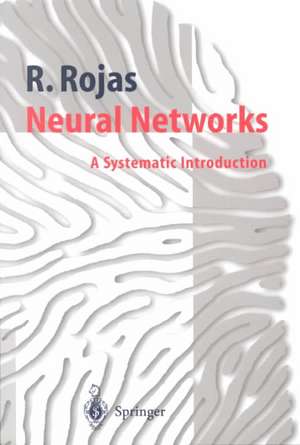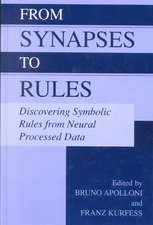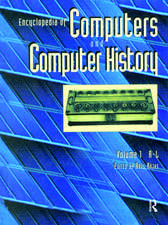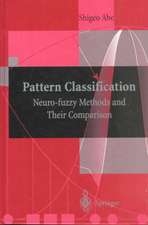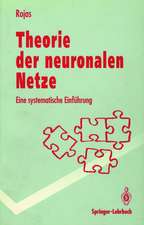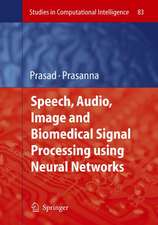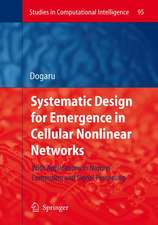Neural Networks: A Systematic Introduction
Autor Raul Rojas Cuvânt înainte de J. Feldmanen Limba Engleză Paperback – 12 iul 1996
Preț: 599.76 lei
Preț vechi: 749.70 lei
-20% Nou
Puncte Express: 900
Preț estimativ în valută:
114.78€ • 124.63$ • 96.41£
114.78€ • 124.63$ • 96.41£
Carte tipărită la comandă
Livrare economică 22 aprilie-06 mai
Preluare comenzi: 021 569.72.76
Specificații
ISBN-13: 9783540605058
ISBN-10: 3540605053
Pagini: 524
Ilustrații: XX, 502 p. 154 illus.
Dimensiuni: 155 x 235 x 28 mm
Greutate: 0.73 kg
Editura: Springer Berlin, Heidelberg
Colecția Springer
Locul publicării:Berlin, Heidelberg, Germany
ISBN-10: 3540605053
Pagini: 524
Ilustrații: XX, 502 p. 154 illus.
Dimensiuni: 155 x 235 x 28 mm
Greutate: 0.73 kg
Editura: Springer Berlin, Heidelberg
Colecția Springer
Locul publicării:Berlin, Heidelberg, Germany
Public țintă
Professional/practitionerCuprins
1. The Biological Paradigm.- 1.1 Neural computation.- 1.2 Networks of neurons.- 1.3 Artificial neural networks.- 1.4 Historical and bibliographical remarks.- 2. Threshold Logic.- 2.1 Networks of functions.- 2.2 Synthesis of Boolean functions.- 2.3 Equivalent networks.- 2.4 Recurrent networks.- 2.5 Harmonic analysis of logical functions.- 2.6 Historical and bibliographical remarks.- 3.Weighted Networks — The Perceptron.- 3.1 Perceptrons and parallel processing.- 3.2 Implementation of logical functions.- 3.3 Linearly separable functions.- 3.4 Applications and biological analogy.- 3.5 Historical and bibliographical remarks.- 4. Perceptron Learning.- 4.1 Learning algorithms for neural networks.- 4.2 Algorithmic learning.- 4.3 Linear programming.- 4.4 Historical and bibliographical remarks.- 5. Unsupervised Learning and Clustering Algorithms.- 5.1 Competitive learning.- 5.2 Convergence analysis.- 5.3 Principal component analysis.- 5.4 Some applications.- 5.5 Historical and bibliographical remarks.- 6. One and Two Layered Networks.- 6.1 Structure and geometric visualization.- 6.2 Counting regions in input and weight space.- 6.3 Regions for two layered networks.- 6.4 Historical and bibliographical remarks.- 7. The Backpropagation Algorithm.- 7.1 Learning as gradient descent.- 7.2 General feed-forward networks.- 7.3 The case of layered networks.- 7.4 Recurrent networks.- 7.5 Historical and bibliographical remarks.- 8. Fast Learning Algorithms.- 8.1 Introduction — classical backpropagation.- 8.2 Some simple improvements to backpropagation.- 8.3 Adaptive step algorithms.- 8.4 Second-order algorithms.- 8.5 Relaxation methods.- 8.6 Historical and bibliographical remarks.- 9. Statistics and Neural Networks.- 9.1 Linear and nonlinear regression.- 9.2 Multiple regression.- 9.3Classification networks.- 9.4 Historical and bibliographical remarks.- 10. The Complexity of Learning.- 10.1 Network functions.- 10.2 Function approximation.- 10.3 Complexity of learning problems.- 10.4 Historical and bibliographical remarks.- 11. Fuzzy Logic.- 11.1 Fuzzy sets and fuzzy logic.- 11.2 Fuzzy inferences.- 11.3 Control with fuzzy logic.- 11.4 Historical and bibliographical remarks.- 12. Associative Networks.- 12.1 Associative pattern recognition.- 12.2 Associative learning.- 12.3 The capacity problem.- 12.4 The pseudoinverse.- 12.5 Historical and bibliographical remarks.- 13. The Hopfield Model.- 13.1 Synchronous and asynchronous networks.- 13.2 Definition of Hopfield networks.- 13.3 Converge to stable states.- 13.4 Equivalence of Hopfield and perceptron learning.- 13.5 Parallel combinatorics.- 13.6 Implementation of Hopfield networks.- 13.7 Historical and bibliographical remarks.- 14. Stochastic Networks.- 14.1 Variations of the Hopfield model.- 14.2 Stochastic systems.- 14.3 Learning algorithms and applications.- 14.4 Historical and bibliographical remarks.- 15. Kohonen Networks.- 15.1 Self-organization.- 15.2 Kohonen’s model.- 15.3 Analysis of convergence.- 15.4 Applications.- 15.5 Historical and bibliographical remarks.- 16. Modular Neural Networks.- 16.1 Constructive algorithms for modular networks.- 16.2 Hybrid networks.- 16.3 Historical and bibliographical remarks.- 17. Genetic Algorithms.- 17.1 Coding and operators.- 17.2 Properties of genetic algorithms.- 17.3 Neural networks and genetic algorithms.- 17.4 Historical and bibliographical remarks.- 18. Hardware for Neural Networks.- 18.1 Taxonomy of neural hardware.- 18.2 Analog neural networks.- 18.3 Digital networks.- 18.4 Innovative computer architectures.- 18.5 Historical and bibliographicalremarks.
Recenzii
"If you want a systematic and thorough overview of neural networks, need a good reference book on this subject, or are giving or taking a course on neural networks, this book is for you." Computing Reviews
Textul de pe ultima copertă
Artificial neural networks are an alternative computational paradigm with roots in neurobiology which has attracted increasing interest in recent years. This book is a comprehensive introduction to the topic that stresses the systematic development of the underlying theory. Starting from simple threshold elements, more advanced topics are introduced, such as multilayer networks, efficient learning methods, recurrent networks, and self-organization. The various branches of neural network theory are interrelated closely and quite often unexpectedly, so the chapters treat the underlying connection between neural models and offer a unified view of the current state of research in the field.
The book has been written for anyone interested in understanding artificial neural networks or in learning more about them. The only mathematical tools needed are those learned during the first two years at university. The text contains more than 300 figures to stimulate the intuition of the reader and to illustrate the kinds of computation performed by neural networks. Material from the book has been used successfully for courses in Germany, Austria and the United States.
The book has been written for anyone interested in understanding artificial neural networks or in learning more about them. The only mathematical tools needed are those learned during the first two years at university. The text contains more than 300 figures to stimulate the intuition of the reader and to illustrate the kinds of computation performed by neural networks. Material from the book has been used successfully for courses in Germany, Austria and the United States.
